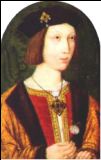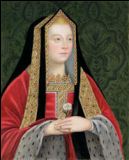2 APRIL 1502
 Death of Arthur, Prince of Wales, first son of Henry VII and Elizabeth of York (daughter of Edward IV and Elizabeth Woodville) at Ludlow Castle, Shropshire, buried in Worcester Cathedral.
Death of Arthur, Prince of Wales, first son of Henry VII and Elizabeth of York (daughter of Edward IV and Elizabeth Woodville) at Ludlow Castle, Shropshire, buried in Worcester Cathedral.
Tags: Elizabeth of York, Henry Tudor
 Birth of Henry (later Henry VIII) at Greenwich Palace, sixth child of Henry VII and Elizabeth of York (daughter of Edward IV and Elizabeth Woodville). He became heir to the throne after the death of his brother Arthur in 1502, and became king on his father’s death on 21 April 1509.
Birth of Henry (later Henry VIII) at Greenwich Palace, sixth child of Henry VII and Elizabeth of York (daughter of Edward IV and Elizabeth Woodville). He became heir to the throne after the death of his brother Arthur in 1502, and became king on his father’s death on 21 April 1509.
Illustration: Henry VIII, 1509, by an unknown artist. The Denver Art Museum.
Tags: Elizabeth of York, Henry Tudor, Henry VIII
 Death of Arthur, Prince of Wales, first son of Henry VII and Elizabeth of York (daughter of Edward IV and Elizabeth Woodville) at Ludlow Castle, Shropshire, buried in Worcester Cathedral.
Death of Arthur, Prince of Wales, first son of Henry VII and Elizabeth of York (daughter of Edward IV and Elizabeth Woodville) at Ludlow Castle, Shropshire, buried in Worcester Cathedral.
Tags: Elizabeth of York, Henry Tudor
Birth of Elizabeth of York on 11 February 1466 at Westminster. She was the eldest child of Edward IV and Elizabeth Woodville.
After Edward’s invasion of France in 1475, in the Treaty of Picquigny, she was supposed to marry to Dauphin Charles. This marriage never took place. After her father’s death on 9 April 1483, she went with her mother and siblings into sanctuary at Westminster. On Christmas Day 1483, Henry Tudor took an oath in Rennes Cathedral to marry her, if he managed to become king.
She left sanctuary with her mother and siblings on 1 April 1484. Richard III undertook to find suitable husbands for her and her sisters. This came to nothing and on 22 August 1485 Richard lost his life and throne at the Battle of Bosworth. The victorious Henry Tudor was in no rush to marry her. Parliament reminded him on 10 December 1485, and the wedding finally took place on 18 January 1486. Her coronation was nearly two years later on 25 November 1487.
Elizabeth and Henry had eight children, of which four survived infancy. She died on her 37th birthday, 11 February 1503, at Richmond Palace, after giving birth to her youngest daughter Katherine on 2 February 1503, probably from post-partum infection. She is buried next to her husband, who died in 1509, in a magnificent marble tomb in Westminster Abbey.
Rosemary Horrox, ‘Elizabeth (1466–1503)’, Oxford Dictionary of National Biography, Oxford University Press, 2004. [last accessed online 1 Feb. 2020]
Richard Cavendish, ‘The Death of Elizabeth of York’, History Today, Volume 53, Issue 2 (2003). URL: http://www.historytoday.com/richard-cavendish/death-elizabeth-york [last accessed 1 Feb. 2020]
P.W. Hammond, ‘The Coronation of Elizabeth of York’, The Ricardian, Vol VI, No 83 (December 1983), pp. 270-272
Dorothea Preis
Tags: Elizabeth of York
 Coronation of Elizabeth of York
Coronation of Elizabeth of York
Tags: Elizabeth of York
 Birth of Arthur, Prince of Wales, first son of Henry VII and Elizabeth of York (daughter of Edward IV and Elizabeth Woodville) at Winchester.
Birth of Arthur, Prince of Wales, first son of Henry VII and Elizabeth of York (daughter of Edward IV and Elizabeth Woodville) at Winchester.
Tags: Elizabeth of York, Henry Tudor
On 18 January 1486, Henry VII (Tudor) married Elizabeth of York, eldest daughter of Edward IV and Elizabeth Woodville. It seems Henry needed to be urged by Parliament to make good his promise to marry Elizabeth, before actually doing so. Plans for Elizabeth’s coronation were only made in September 1487 and she was finally crowned on 25 November 1487, more than a year after giving birth to their first son, Arthur.
Elizabeth died on 11 February 1503 at Richmond Palace. Henry died six years later, on 21 April 1509, also at Richmond Palace. They are buried next to each other in Westminster Abbey.
Reference: Rosemary Horrox, ‘Elizabeth (1466–1503)’, Oxford Dictionary of National Biography, Oxford University Press, 2004. (online accessed: 27 January 2011)
Tags: Edward IV, Elizabeth of York, Elizabeth Woodville, Henry Tudor
 Barbara Gaskell Denvil. No surprise there for New South Wales Branch members and visitors to our website. Barbara’s imaginative and beautifully written books, Satin Cinnabar and Sumerford’s Autumn, and her well-researched features are much appreciated.
Barbara Gaskell Denvil. No surprise there for New South Wales Branch members and visitors to our website. Barbara’s imaginative and beautifully written books, Satin Cinnabar and Sumerford’s Autumn, and her well-researched features are much appreciated.
Her latest achievement is winning a copy of a young person’s novel The Disappearing Rose, by Canadian writer Renee Duke who, keen to promote her latest work, organised a competition on Lynne Murray’s blog to find out who people thought were responsible for the disappearance of the two Princes. Good idea – until she was alarmed to discover that Richard was winning!
An emergency email for help arrived in Julia’s inbox and, naturally, Julia sent a plea to all New South Wales members and friends to show that loyalty binds them and to save Richard from this undesirable fate!
And so they did. Renee reports that 34% of the votes and comments were from Australia which in a world-wide competition is pretty terrific – and Barbara’s comment was the winner. The overall results were:
First: Margaret Beaufort
Second: Henry VII and Richard III (tie)
Third: Henry, Duke of Buckingham and Elizabeth of York (another tie)
Fourth: Sir Thomas More
Fifth: two write-ins: No one (’cos they survived) and Henry VIII (he time-travelled)
Barbara’s winning comment was different again. She says,“I basically explained – very briefly – why I thought the princes actually survived.”
And that seems much more logical than the suggestion of the sainted More; his tender age when the princes disappeared makes it unlikely that he could have organised the event!
So, what of the book The Disappearing Rose? It is for young people, especially those who love time travel, history, mystery and adventure.
“No one knows what happened to the little Princes of the Tower. That’s what Dane, Paige, and Jack are told when they start working on a medieval documentary for Dane and Paige’s filmmaker father. But then an ancient medallion transports them back to the fifteenth century and gives them a chance to discover the truth about the mysterious disappearance of young King Edward the Fifth and his brother Richard, Duke of York. But they’d better be careful. The princes are definitely in danger, and the person responsible for their disappearance just might decide that their new friends should disappear as well.”
Sounds like good reading for tweens, teens and those over 21 too. The good news is it is the first in The Time Rose series. It is an e-book and more information can be found on http://museituppublishing.com.
Renee Duke, the author, grew up in England and says she has been interested in the princes ever since she read about them in a text book of the Uncle-Richard-did-it variety that still prevails. She’s hoping that the time travel approach will lure high tech fantasy obsessed children of today into considering other possible culprits.
Tags: Books, Elizabeth of York, Henry Tudor, Henry VIII, Margaret Beaufort, NSW Branch, Princes, Richard III, Thomas More
The following question comes from Pamela J Butler, one of our friends from the American Branch of the Richard III Society. Did you know the answer?
 Name a medieval woman who fits this description:
Name a medieval woman who fits this description:
1. She lived in the late fifteenth century and into the sixteenth century for a few years.
2. She was beautiful and blonde
3. Her father was a powerful ruler, but a bit on the licentious side.
4. Her family used her as a political pawn to further their own ambitions.
5. She died in her late thirties after giving childbirth to a girl.
Yep, you got it! Read the rest of this entry »
Tags: Elizabeth of York